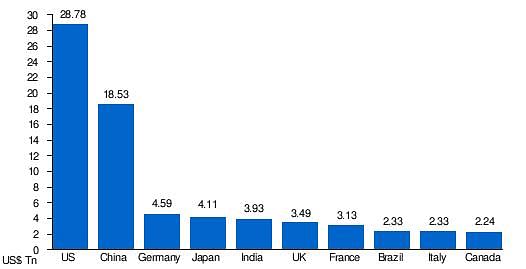Ramesh Singh Test: Economics - 2 - UPSC MCQ
25 Questions MCQ Test Indian Economy for UPSC CSE - Ramesh Singh Test: Economics - 2
Arrange the following countries in a descending order according to their GDP
1. India
2. U.S.A
3. China
4. Germany
5. Japan
1. India
2. U.S.A
3. China
4. Germany
5. Japan
Which of the following is not an intermediate good?
| 1 Crore+ students have signed up on EduRev. Have you? Download the App |
Which of the following is/are included in the expenditure method of GDP calculation?
1. Private consumption
2. Government Consumption
3. Net exports
4. Investments
5. Firm profits
1. Private consumption
2. Government Consumption
3. Net exports
4. Investments
5. Firm profits
Which is considered as the official GDP of India?
When was the base year changed to 2011-12 from 2004-04?
Which of the following comes under Macroeconomics?
1. Gross Domestic product
2. National income
3. Inflation
4. Profits of a firm
5. Demand and supply
Select the correct answer from the options given below:
The Gross National Product (GNP) of India is less than its Gross Domestic Product (GDP) because
Which of the following is/are not included in GDP calculation?
1. Foods and services provided free of cost by a NGO
2. Housewives' works
3. A doctor treating his own children
4. Goods in the inventory
Consider the following statements.
1. Factor income from abroad is included in the GDP.
2. GDP gives importance to who produces goods and services rather than where it is produced.
3. Negative externalities are taken in to consideration while calculating GDP.
4. Care economy is excluded from GDP.
Which of the above statements is/are not correct?
Consider the following statements.
1. The concept of economic growth is quantitative whereas economic development is qualitative.
2. The concept of inclusive growth is associated with economic development.
Identify the correct statement/s.
In terms of Purchasing Power Parity (PPP), India is the ______ largest economy in the world.
Who publishes the Human Development Report every year?
The Economist who developed Human Development Index (HDI) is
The first Human Development Report was published in
What is the title of Human Development Report 2023-24?
HDI measures human development in a country using which of the following indicators?
1. Life expectancy
2. Education
3. Per capital income
4. Gender empowerment
5. Research and development
How many countries are covered in the Human Development Index (HDI) of 2019?
Consider the following statements:
- India ranks 108 out of 166 countries in the Gender Inequality Index (GII) 2022.
- India’s adolescent birth rate improved from 17.1 in 2021 to 16.3 in 2022.
- India's GII value of 0.437 is higher than the global average of 0.462.
How many of the statements given above are correct?
Which of the following statement/s about Gender Inequality Index is not true?
Consider the following statements:
- India's HDI ranking improved from 135 in 2021 to 134 in 2022.
- Switzerland is ranked number one on the HDI in 2022.
- The HDI was developed by economist Amartya Sen.
How many of the statements given above are correct?
The concept of Gross National Happiness (GNH) was first introduced in
|
110 videos|315 docs|136 tests
|
|
110 videos|315 docs|136 tests
|


















